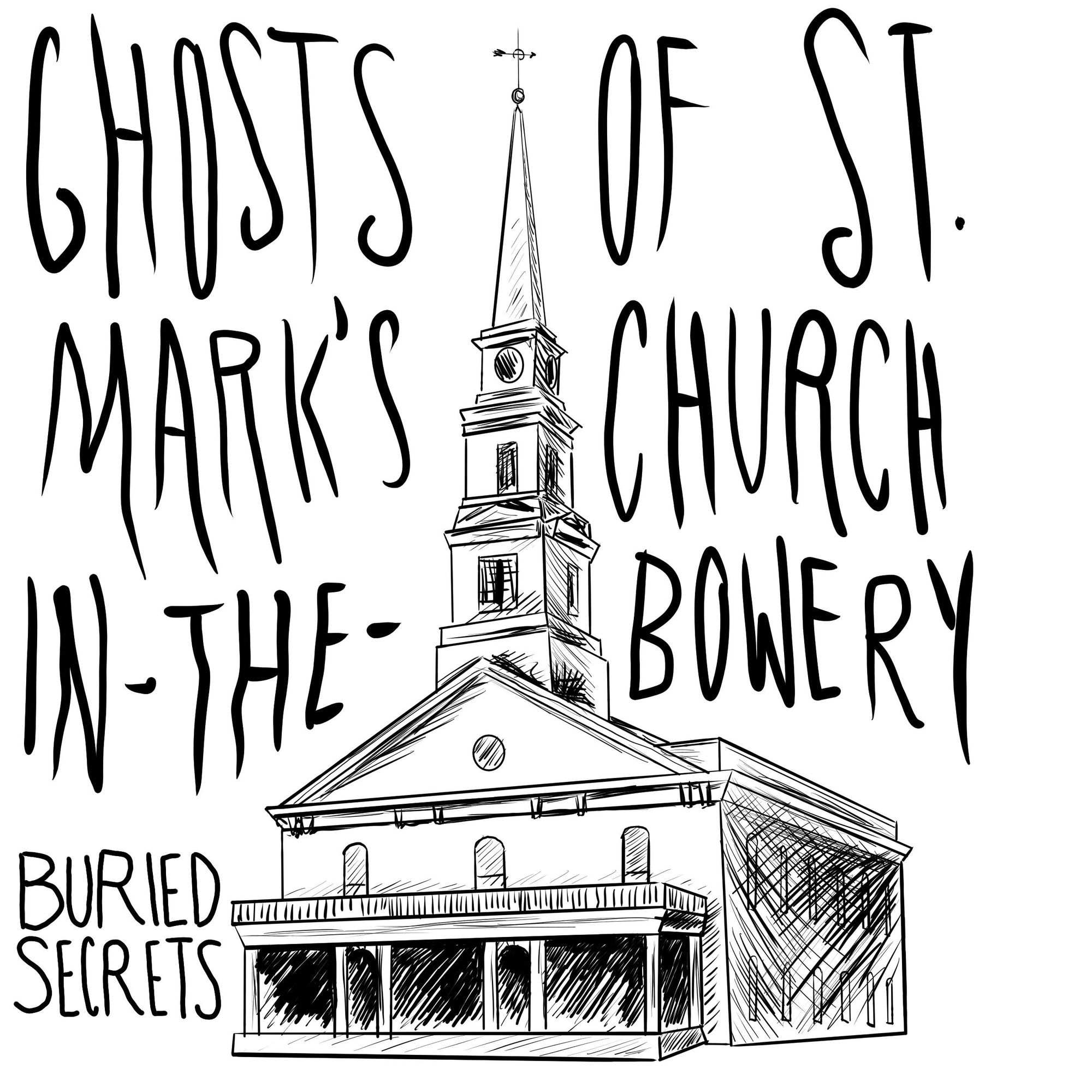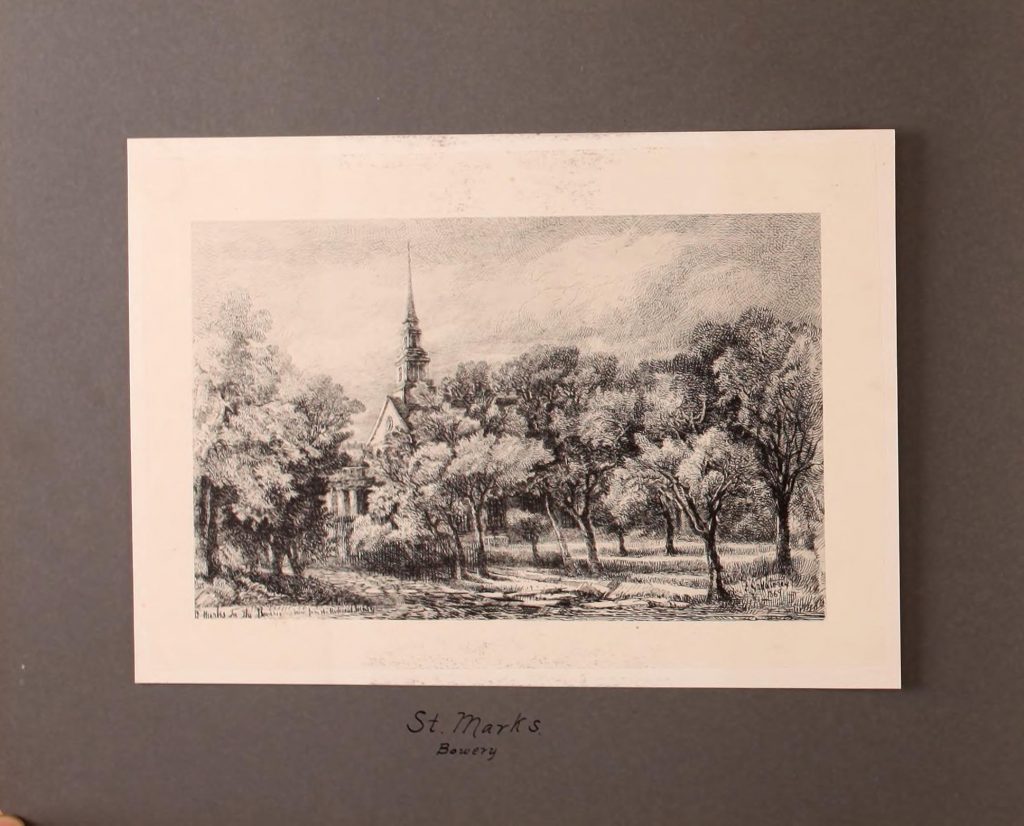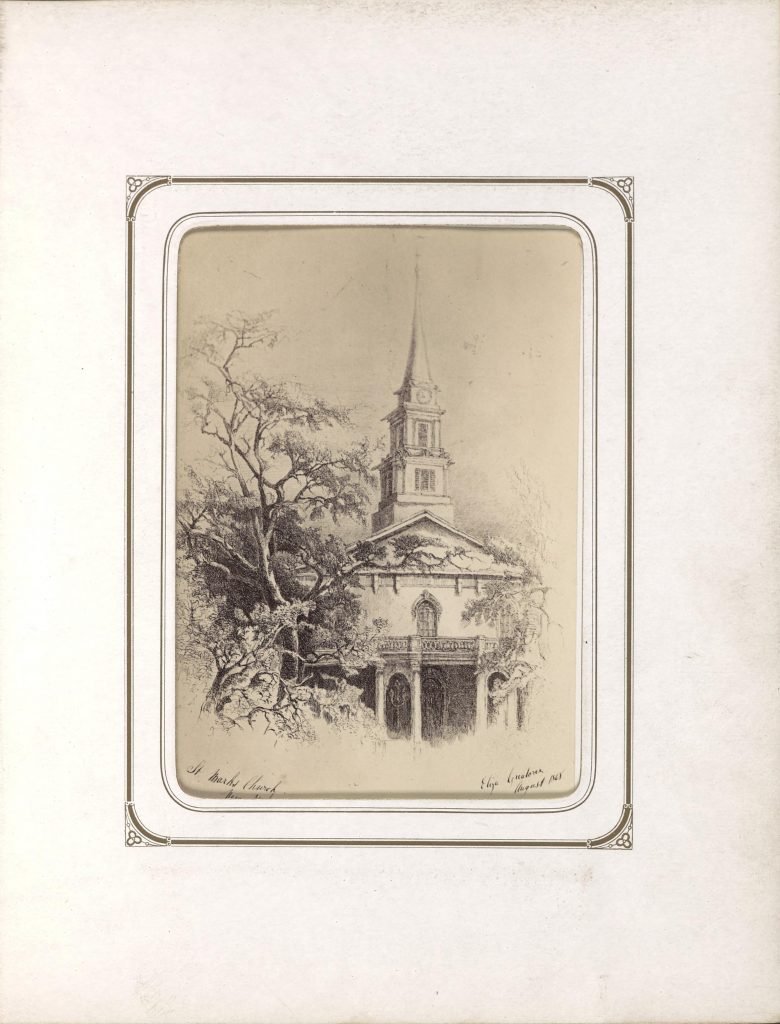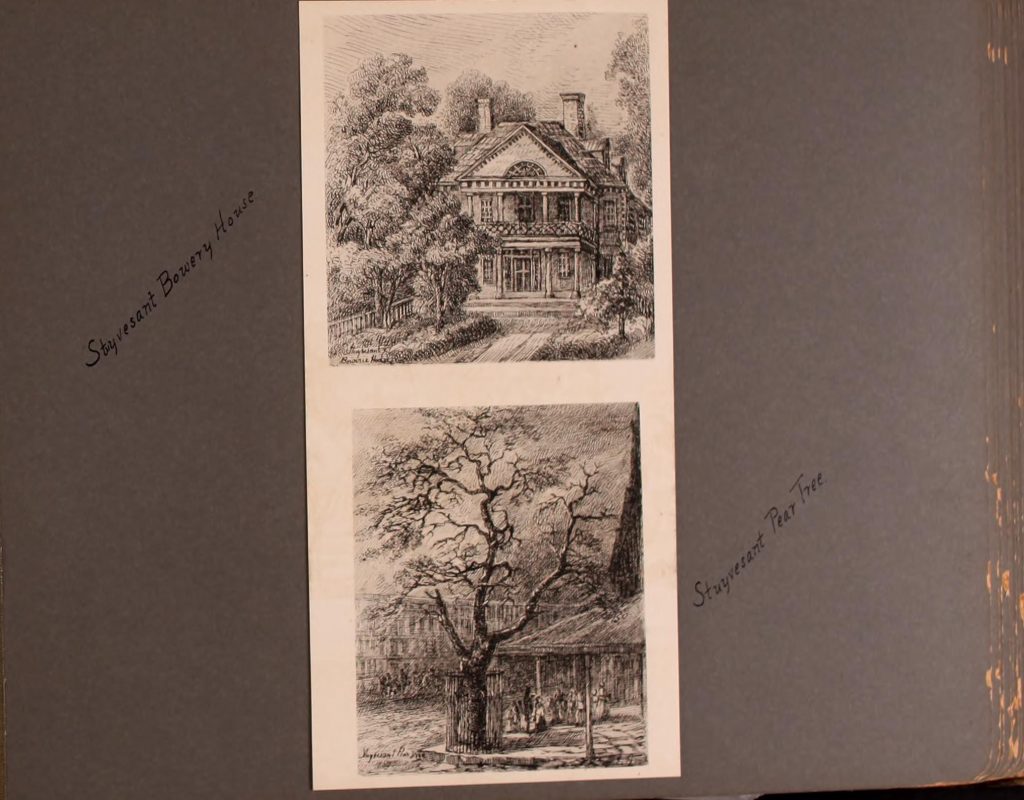Haunted St. Mark's Church-in-the-Bowery

A look at haunted St. Mark’s Church-in-the-Bowery, the second-oldest church still standing in Manhattan, which is full of hauntings both legendary and questionable.
Highlights include:
• A wealthy man’s remains being stolen and held for ransom
• A very grumpy ghost
• An heir who convened with his ancestor’s ghost instead of marrying
• A mysteriously ringing church bell
You can listen to more audio on patreon ($3/month): https://www.patreon.com/buriedsecrets
Follow us on instagram @buriedsecretspodcast
E-mail us at buriedsecretspodcast@gmail.com.
Pictures of Haunted St. Mark’s Church-in-the-Bowery

St Mark’s Church-in-the-Bowery from Etchings of Old New York, 1875

St. Mark’s Church-in-the-Bowery from Relics of Manhattan (1869) by Eliza Greatorex

Stuyvesant Bowery House from Etchings of Old New York, 1875
Episode Script for Haunted St. Mark’s Church-in-the-Bowery
DISCLAIMER: I’m providing this version of the script for accessibility purposes. It hasn’t been proofread, so please excuse typos. There are also some things that may differ between the final episode and this draft script. Please treat the episode audio as the final product.
- After St. Paul’s, the second oldest church in the city is St. Mark’s Church in-the-Bowery, and the fourth oldest building in the city.
- The location has been a place of worship since 1660, when the last Dutch governor of New York, Peter Stuyvesant, bought the land for a farm and built a chapel on the site of today’s St. Mark’s church. The 300 acres of farm were the best farmland on the whole island of Manhattan.
- Peter Stuyvesant was known for being a jerk, a bigot, and an anti-Semite. Most websites tend to call him stuff like “a stern leader” but let’s call a spade a spade here.
- He had lost a leg during a conflict with the Spanish in the West Indies, so he used a peg-leg with silver studs.
- In 1672, Stuyvesant died, and was buried in the vault beneath the chapel.
- Throughout the 1700s, the chapel fell into disrepair. Eventually, there was just the foundation and the Stuyvesant family vault beneath it.
- In 1793, Peter Stuyvesant IV, the original Peter Stuyvesant’s great-grandson, donated the chapel to the Episcopal Church (the family had converted), on the condition that a new church be built there.
- In 1799, St. Mark’s in-the-Bowery was completed. It was the first Episcopal parish that was separate from Trinity church, which we talked about last time.
- During the first half of the 19th century, there were two burial sites affiliated with the church.
- The first was the yards around the church, which was for vault interments
- The first vaults were built in 1807.
- Many of NYC’s rich and famous were buried there.
- In 1876, a millionaire named AT Stewart was buried in the east yard.
- Stewart had an early department store, which made him rich
- two years after he was buried, someone stole his remains and held them for ransom.
- The case was never resolved as far as the public is concerned, but some people say that his widow negotiated to get the remains back in 1881. The ransom was supposedly $200K and she negotiated it down to $20K. His body was supposedly hidden at his department store until an Episcopal church was built on Long Island in 1884, and his remains were moved there.
- Some people claim to see his restless ghost. And during the 19th century, it seems that people claimed to see his ghost at his store and at St. Mark’s.
- There was also a nearby cemetery, east on 11th street, for regular graves. Peter Stuyvesant IV had donated it as a burial ground in 1803, on the condition that any of the current or former enslaved people who he owned, or their children, would be buried there for free. And yes, there were slave-owners in NYC in the 19th century, until 1827; check out the last episode for a bit more about slavery in NYC.
- It’s unclear how many people were buried there, but the burial ground was closed in 1851, and then the remains were moved to Evergreens Cemetery in Brooklyn in 1864 and residential buildings were built on the site.
- The first was the yards around the church, which was for vault interments
- The Stuyvesant vault is still at the church, beneath the east wall, but it was closed for good when the last Stuyvesant was buried there in 1953.
- The Stuyvesants were always the richest or second-richest family in NYC until they died out.
- Apparently the last Stuyvesant didn’t marry, but he was known for going to the church every Sunday for hours to commune with Peter Stuyvesant’s spirit. At his funeral, some people claimed to hear the rapping of a peg leg as if it was greeting him as he was buried in the vault.
- Though the Stuyvesants are gone, their ancestors remain. For example, the Wainwrights–like Loudon Wainwright III, Rufus Wainwright, and Martha Wainwright, are descended from the family.
- Legend has it that Peter Stuyvesant haunts the church. Though before haunting the church, he haunted his family mansion, scaring the servants into dropping and breaking dishes and crockery. One of his daughters claimed to see him.
- After the mansion burned down in 1744, people started seeing him where his remains were buried. He was also sighted inspecting the remains of the destroyed mansion.
- Then, in 1831, he was sighted again, as the city built second avenue through his family’s farm, and again in 1900, when second avenue was widened. He was not successful in scaring off the workmen.
- He’s supposedly unhappy with how the city has grown and how his old farmland is overrun with so much noise and activity. It’s said that he was once so disturbed by the sounds of the city that he awoke from his slumber to ring the bells of the church angrily.
- He also supposedly interrupts services by stomping around and singing Dutch hymns, since as I talked about last week, he was anti-pretty much every religion than the Dutch Reformed Church that he was a member of. So apparently he doesn’t appreciate being buried beneath an Episcopalian church.
- There’s a story about a sexton who went into the church late at night to grab something for the rector, when he saw the ghost of Stuyvesant. The sexton ran away, and then Stuyvesant walked through the locked church door and began pulling on the bell rope.
- Back in the day, church bells were rung for emergencies like a fire or big announcement.
- So the story goes that when people rushed to the church to see what was going on, the church was empty. But the bell rope had been torn and the lower part of the rope was gone.
- To read a passage from a 1966 children’s book called The Ghost of Peg-Leg Peter by M.A. Jagendorf
- “His body had been put into a closed vault. But that did not stop the ghost of the governor from stomping around on black or moonlit nights in his old haunts; his farm and the city hall where he had once reigned. Folks heard his stomping peg leg with the silver band, and saw him — and ran away in fear. Â That pleased him, particularly if they were English. He wanted no one around his grave, least of all the enemy who had robbed him and the Dutch Government.”
- I’ve also read another version of the story, which I’m inclined to believe more, because it makes more sense and has more specificity. According to the book Haunted Manhattan, on Good Friday, April 14, 1865, the church bell began ringing. The rector hurried out to take a look, and saw a ghost with a peg leg in period Dutch clothes running away. What made this strange was that the bell was rung without the rope: the bell rope had been cut off a few days before. Then, the next night, the bell rope was seen on the Stuyvesant family vault.
- There’s another great story in the same book, which is that during the 1930s, a priest always noticed that a young man sat in the same corner and stared in his direction during his sermon. I don’t know why that would have stood out, unless the priest really wasn’t used to people paying attention, which does seem possible.
- The priest finally asked the young man what he was looking at, and the man said that when the priest gave sermons, he saw a man in Dutch period costume with a peg leg, alongside a woman in Dutch period costume
- There’s a different version of that same story in Hans Holzer’s books Real Hauntings and This House Is Haunted. I’m inclined to believe Holzer’s account over the story from Haunted Manhattan, because it has more specificity and because Holzer seems to have conducted the interviews personally. Both Real Hauntings and This House Is Haunted tell the same story almost word for word, but I’ll read the version from Real Hauntings:
- “I talked to the Reverend Richard E. McEvoy, later Archdeacon of St.John’s, but for many years rector of St. Mark’s, about any apparitions he or others might have seen in the church. Legend, of course, has old Peter Stuyvesant rambling about now and then. The reverend proved to be a keen observer, and quite neutral in the matter of ghosts. He himself had not seen anything unusual. But there was a man, a churchgoer, whom he had known for many years. This man always sat in a certain pew on the right side of the church.
- Queried by the rector about his peculiar insistence on that seat, the man freely admitted it was because from there he could see “her”—the “her” being a female wraith who appeared in the church to listen to the sermon, and then disappeared again. At the spot he had chosen, he could always be next to her! I pressed the rector about any personal experiences. Finally he thought that he had seen something like a figure in white out of the corner of one eye, a figure that passed, and quickly disappeared. That was ten years before.”
- Holzer tells another story about a man he spoke to on the advice of the rector, a Foreman Cole, who came regularly to wind the clock at St. Mark’s, and who’d been in and around St. Mark’s for 26 years.
- Cole once saw someone in the balcony at 1 am.
- And 15 years before that sighting, he had a more specific and dramatic one. I’ll read directly from Real Hauntings since Holzer tells the story so well:
- “It was winter, and the church was closed to the public, for it was after 5:00
- P.M. That evening it got dark early, but there was still some light left when Cole let himself into the building. Nobody was supposed to be in the church at that time, as Cole well knew, being familiar with the rector’s hours.
- Nevertheless, to his amazement, he clearly saw a woman standing in the back of the church, near the entrance door, in the center aisle. Think-
- ing that she was a late churchgoer who had been locked in by mistake, and worried that she might stumble in the semidarkness, he called out to her, “Wait, lady, don’t move till I turn the lights on.”
- He took his eyes off her for a moment and quickly switched the lights on. But he found himself alone; she had vanished into thin air from her spot well within the nave of the church.
- Unnerved, Cole ran to the entrance door and found it firmly locked. He then examined all the windows and found them equally well secured.
- I asked Cole if there was anything peculiar about the woman’s appearance. He thought for a moment, then said, “Yes, there was. She seemed to ignore me, looked right through me, and did not respond to my words.”
- Six weeks later, he had another supernormal experience. Again alone in the church, with all doors locked, he saw a man who looked to him like one of the Bowery derelicts outside. He wore shabby clothes and did not seem to “belong” here. Quickly, Cole switched on the lights to examine his visitor. But he had vanished, exactly as the woman had.”
- Holzer reports that Cole had other experiences as well, including hearing frequent banging, “uncanny” feelings, chills in some areas of the church, and footsteps when no one was there.
- One caveat here: I’m not sure whether the church has radiator heat, but I assume that it probably does (rather than having been retrofitted with a more recent climate control.) If that’s the case, it’s very common for radiators to build up calcium deposits which then bang loudly through the pipes. I experienced this when I was at Fordham, which was the last place I lived with working radiator heat, and it was always a surprise how erratic and loud the radiators could be. So anytime I hear about banging in an old building, without an explanation of why it couldn’t be a radiator (like if it was summer or something), I’m a little wary.
- Holzer also brought in a psychic, who had been to the church once when she was in the neighborhood and felt it was haunted. The psychic said that she felt “a man with a cane walking down the middle aisle behind us.” Holzer supposed that was Peter Stuyvesant. Then she said she saw a woman in wide skirts near the back door of the church, and, to quote her: “I see a white shape floating away from that marble slab in the rear!”
- I mention this psychic story because they’ve been written in a couple books and therefore are part of the lore of the church, however, I find them extremely dubious, especially since St. Mark’s is a famously haunted church and I’m sure the psychic had heard some of its stories.
- My philosophy when considering paranormal events is this:
- If someone believes they saw something, and genuinely believe it was something paranormal, then I give them the benefit of the doubt and believe that they had some sort of paranormal experience, in their own personal perception, whether or not they have any real proof.
- However, I’d say that I’m a skeptical believer. And I find stories credible when there are a bunch of different inputs or data points that point to something being the case, particularly when someone didn’t know the history of whatever paranormal spot where they were.
- So for example, I experienced a few things during a trip to Salem that I went on last year, as did Jen, who’s been on the podcast in the past, and my wife, Amy. Because several disparate things happened to us: all three of us experienced the estes session, which was spooky but only partially conclusive, and then Jen had a possible sleep paralysis experience, and then I found an extremely clear EVP on a recording that Jen also listened to and corroborated, then I feel like we were genuinely onto something.
- My suspicions were confirmed when I did additional research on the Hawthorne Hotel and that part of Salem months later, and learned things that 1) I hadn’t been aware of, 2) which weren’t readily available online (I had to really dig through historical records), and 3) fit together as part of a narrative that made some sort of sense to me, though I still have many unanswered questions
- So there are some things that I feel like are as solid as they can be, and which I don’t have a problem asking other people to believe my experience for the most part. However, I wouldn’t be surprised or upset if people were skeptical about my experience of the EVP, since Jen and I heard it really clearly in Salem, but once I left Salem, the recording sounded fairly different and it was much less clear when I listened back to it. And because it was recorded on a sleep tracking app on my phone, I haven’t been able to successfully share it with other people.
- Because of that, if someone wants to say my EVP experience was BS, then I totally get it, though for myself, I believe it was real, and I have a lot of questions about why I could only hear it clearly in our hotel room where it was recorded.
- So with that example out of the way, when someone has no narrative proof for what they experience (like if they just get a vibe or impression), that might suggest that something’s up, or it might not. There just isn’t enough information. But the story becomes more suspect if they have a vested interest in having had an experience, or if it fits neatly into a story and confirms an existing bias. And that goes doubly if it confirms and existing and widely-known story.
- Also, I know that Hans Holzer was criticized for sometimes having unsubstantiated claims and being not totally trustworthy.
- So, with that out of the way, I wanted to move onto another story about St. Mark’s from Haunted Manhattan: On Christmas Day 1995, the congregation heard someone singing “One hundred bottles of rum” and when they went to the room that held refreshments, they saw someone in Dutch period costume and a peg leg walk into the wall. The punchbowl had been drunk down an inch
- And the author of Haunted Manhattan said he spoke to a woman in 2003 who attended late-night services, and she heard what sounded like a peg leg behind her.
- People have also said that they’ve seen strange shadows in the windows from the street, and the sound of a peg-leg has been reported inside the church
- Supposedly there’s also the ghost of a woman in the church, though I see that fewer places. She’s supposed to be wearing period clothing–though I’m not sure from which period–and disappears when you get too close. She’s been seen in the pews and the balcony.
- Apparently St. Mark’s Church rents out some rooms in the rectory; according to the book Ghosts of Manhattan, a writer reported that when she lived there, her dog got really scared and wouldn’t go into one room unless she was there. She also said she saw people’s shadows even when no one was there.
Sources consulted RE: Haunted St. Mark’s Church-in-the-Bowery
Books
- Real Hauntings by Hans Holzer (1995)
- This House is Haunted by Hans Holzer (1997)
- Walks in Our Churchyards: Old New York, Trinity Parish By John Flavel Mines · 1896
- Ghosts of Manhattan: Legendary Spirits and Notorious Haunts by Philip Ernest Schoenberg · 2009
- Etchings of Old New York, Illustrations from “Old New York: from the Battery to Bloomingdale” by Eliza Greatorex and M. Despard (1875)
- Relics of Manhattan [electronic resource] : a series of photographs, from pen and ink sketches taken on the spot (1869) by Eliza Greatorex
Websites
- https://www.businessinsider.com/the-haunted-history-of-lower-manhattan-2015-10
- https://www.huffpost.com/entry/wall-streets-slave-peddli_n_1147314
- https://www.nps.gov/afbg/learn/historyculture/enslavement.htm
- https://peoplesworld.org/article/slavery-in-new-york-uncovering-the-brutal-truth/
- https://en.wikipedia.org/wiki/Atlantic_slave_trade
- http://www.slaveryinnewyork.org/history.htm
- http://www.slaveryinnewyork.org/about_exhibit.htm
- https://www.nps.gov/afbg/learn/historyculture/enslavement.htm
- https://en.wikipedia.org/wiki/Director_of_New_Netherland
- https://en.wikipedia.org/wiki/Willem_Kieft
- https://en.wikipedia.org/wiki/Kieft%27s_War
- https://en.wikipedia.org/wiki/Fort_Amsterdam
- https://en.wikipedia.org/wiki/Trinity_Church_(Manhattan)
- https://untappedcities.com/2017/06/09/the-top-10-secrets-of-nycs-st-pauls-chapel/?displayall=true
- https://didyouknowfacts.com/the-headless-ghost-of-st-pauls-chapel/
- https://www.trinitywallstreet.org/blogs/archivists-mailbag/trees-inside-st-pauls-chapel
- https://untappedcities.com/2017/06/09/the-top-10-secrets-of-nycs-st-pauls-chapel/?displayall=true
- https://en.wikipedia.org/wiki/St._Paul%27s_Chapel
- https://en.wikipedia.org/wiki/St._Mark’s_Church_in-the-Bowery
- https://en.wikipedia.org/wiki/History_of_slavery_in_New_York_(state)#Half-slavery
- https://en.wikipedia.org/wiki/Land_of_the_Blacks_(Manhattan)
- https://en.wikipedia.org/wiki/Mother_African_Methodist_Episcopal_Zion_Church
- Information about Little Africa and the history of Black people in Greenwich Village: https://greenwichvillage.nyc/blog/2020/02/10/look-black-history-village/
- https://atlantablackstar.com/2015/06/16/burial-remains-tell-the-story-of-new-yorks-little-africa/
- https://www.nytimes.com/2004/05/02/nyregion/in-their-footsteps.html
- https://en.wikipedia.org/wiki/Algonquian_peoples
- https://untappedcities.com/2015/02/25/today-in-nyc-history-a-1643-massacre-of-the-lenape-almost-dooms-new-amsterdam/
- https://www.ncai.org/resources/resolutions/national-american-indian-holocaust-museum
- https://en.wikipedia.org/wiki/African_Burial_Ground_National_Monument
- https://www.trinitywallstreet.org/blogs/trinity-notes/ghosts-trinity
- https://en.wikipedia.org/wiki/Trinity_Church_Cemetery
- https://en.wikipedia.org/wiki/James_J._Walker_Park
- https://en.wikipedia.org/wiki/St._John%27s_Burying_Ground
- https://www.trinitywallstreet.org/blogs/archives/mummy-trinity-church
- https://www.findagrave.com/memorial/74852371/mary-elizabeth-tisdall
- https://ephemeralnewyork.wordpress.com/tag/mary-elizabeth-tisdall/
- https://keithyorkcity.wordpress.com/2012/10/04/st-johns-graveyard-little-leaguers-now-play-ball-above-10000-corpses/
- https://nycemetery.wordpress.com/2011/01/04/st-johns-cemetery/
- https://nycemetery.wordpress.com/2011/06/04/st-marks-in-the-bowery-churchyard-and-cemetery/
- https://nycemetery.wordpress.com/2011/01/14/st-pauls-chapel-churchyard/
- https://www.flickr.com/photos/wallyg/544841964/
- https://www.flickr.com/photos/75469677@N00/4420876543/in/set-72157623465293193/
- https://www.6sqft.com/10-offbeat-spots-that-reveal-new-york-citys-haunted-history/
- https://ny.curbed.com/maps/new-york-city-haunted-buildings-halloween
- https://www.boweryboyshistory.com/2015/10/the-ghost-of-peter-stuyvesant-may-still-haunt-the-east-village.html
- https://www.nypl.org/blog/2010/02/02/where-st-johns-old-burying-ground
- https://nypost.com/2014/10/25/the-hidden-cemeteries-of-nyc/
- https://www.6sqft.com/what-lies-below-nycs-forgotten-and-hidden-graveyards/
- https://daytoninmanhattan.blogspot.com/2010/05/burying-ground-below-ballfield-james.html
- https://www.findagrave.com/cemetery/2389220
- https://en.wikipedia.org/wiki/Trinity_Church_Cemetery
- https://the-line-up.com/haunted-churches
- https://nyghosts.com/st-marks-church-in-the-bowery/
- http://www.weirdus.com/states/new_york/ghosts/st_marks_church/index.php
- https://nyghosts.com/st-marks-church/
- https://forgotten-ny.com/2014/07/adam-allyn-comedian-trinity-church-cemetery/
- https://the-line-up.com/ghosts-st-marks-church-in-the-bowery
- https://the-line-up.com/the-headless-ghost-of-st-pauls-chapel
- https://untappedcities.com/2017/06/09/the-top-10-secrets-of-nycs-st-pauls-chapel/?displayall=true
- https://www.trinitywallstreet.org/blogs/archivists-mailbag/church-wee-hours
- https://www.trinitywallstreet.org/blogs/archivists-mailbag/trees-inside-st-pauls-chapel
- https://en.wikipedia.org/wiki/St._Mark’s_Church_in-the-Bowery
- https://en.wikipedia.org/wiki/Alexander_Turney_Stewart
- https://gomadnomad.com/2011/10/25/new-york-city-haunted-cemeteries/
- http://www.liparanormalinvestigators.com/haunted-places-on-li/the-five-boroughs/trinity-church-cemetery/
- http://www.scoutingny.com/the-masked-lady-of-broadway/
https://nyghosts.com/st-marks-church/ - https://keithyorkcity.wordpress.com/2012/10/04/st-johns-graveyard-little-leaguers-now-play-ball-above-10000-corpses/
- https://daytoninmanhattan.blogspot.com/2010/05/burying-ground-below-ballfield-james.html
Don’t miss our past episodes:
- The Renwick Ruin:
- Investigating the Hawthorne Hotel:
- The Haunted Grove Park Inn, Asheville, North Carolina
- Haunted Asheville, North Carolina
- New York City Potter’s Fields
- Calvary Cemetery, Queens, New York (Part 1)
- Archbishop John Hughes, aka Dagger John: Calvary Cemetery, Queens, New York (Part 2)
- The Haunted Luxor Hotel and Casino, Las Vegas: Part 1
- The Haunted Luxor Hotel and Casino, Las Vegas: Part 2
- A Victorian Lunatic’s Fort: Fort Maxey, Blackwell’s Island, NYC
- The Roosevelt Island Lighthouse, or The Blackwell Island Light, NYC
- The General Slocum Disaster, Hell Gate, New York City
- The Haunted Hell Gate, New York City

